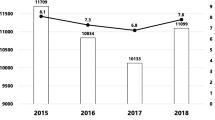Summary
To explore the method of identifying nursing-related patient safety events, types, contributing factors and evaluate consequences of these events in hospitals of China, incident report program was established and implemented in 15 patient units in two teaching hospitals of China to get the relevant information. Among 2935 hospitalized patients, 141 nursing-related patient safety events were reported by nurses. Theses events were categorized into 15 types. Various factors contributed to the events and the consequence varied from no harm to patient death. Most of the events were preventable. It is concluded that incident reporting can provide more information about patient safety, and establishment of a program of voluntary incident reporting in hospitals of China is not only urgent but also feasible.
Similar content being viewed by others
References
Tighe CM, Woloshynowych M, Brown R, et al. Incident reporting in one UK accident and emergency department. Accid Emerg Nurs, 2006,14:27–37
Taylor JA, Brownstein D, Christakis DA, et al. Use of incident reports by physicians and nurses to document medical errors in pediatric patients. Pediatrics, 2004, 114(3):729–735
Buerhaus PI. Lucian Leape on the cause and prevention of errors and adverse events in health care. Image J Nurs Sch, 1999,31(3):281–286
Sharon S. Patient safety: the changing face of error reporting. Rehabil Nurs, 2006,31(2):52–53
Wu AW, Pronovost P, Morlock L. ICU incident reporting systems. J Crit Care, 2002,17(2):86–94
Evans SM, Berry JG, Smith BJ, et al. Attitudes and barriers to incident reporting: a collaborative hospital study. Qual Saf Health Care, 2006,15:39–43
Leape L. Reporting of adverse events. N Engl J Med, 2002,347(20):1633–8
Yamagishi M, Kanda K, Takemura Y. Methods developed to elucidate nursing related adverse events in Japan. J Nurs Manag, 2003,11:168–176
Cao R. Chinese Hospital Association. Healthcare quality and patient safety of China. http://www.cha.org.cn/GD/GeneralDocument/GDContent.aspx?ContentId=41&ClassId=147&ChannelId=33,2008-01-19
Establishment of “Chinese Patient Safety Goal 2007” by Chinese Hospital Association. http://aixin.njmu.edu.cn/News/yyws/200610/7147.html. Published October, 2006. Accessed June 30,2008
Liu YL, Kalisch BJ, Zhang L, Xu J. Perception of safety culture by nurses in hospitals in China. J Nurs Care Qual, 2009,24(1):63–68
Kinston M, Evans SM, Smith BJ, et al. Attitudes of doctors and nurses toward incident reporting: a qualitative analysis. MJA, 2004,181(1):36–39
Li M. Building medial errors and adverse events reporting system to improve patients’ safety. Zhong Guo Hu Li Guan Li (Chinese), 2007,3:43–45
Liu Y, Zhang L, Wang G, et al. Thinking about management of nursing error. Zhong Hua Hu Li Za Zhi (Chinese), 2007,9:827–829
Inoue K, Koizumi A. Application of human reliability analysis to nursing errors in hospitals. Risk Analysis, 2004, 24(6):1459–1473
Chen Y. The problem of patient education in hospital and its coping strategy. Zhong Hua Hu Li Guan Li Za Zhi (Chinese), 2003,3(1):37–38
Kalisch BJ. Missed nursing care, a qualitative study. J Nurs Care Qual, 2006,21(4):306–313
Yang W. The relationship of nursing stuffing level and patients satisfaction. Zhong Hua Hu Li Za Zhi (Chinese), 2007
Beckmann U, Baldwin I, Durie M, et al. Problems associated with nursing staff shortage: An analysis of the first 3600 reports submitted to the Australian incident monitoring study (AIMS-ICU). Anaesth Intensive Care, 1998,26(4):396–400
Tzeng HM, Yin CY. Innovation in patient safety a new task design in reducing patient falls. J Nurs Care Qual, 2008,23(1): 34–42
Shorr RI, Mion LC, Chandlers AM, et al. Improving the capture of patient fall events in hospitals: combining a service for evaluating inpatient falls with an incident report system. JAGS, 200856(4):701–704
American Nurses Association. Nursing Quality Indicators: Definitions and Implications. Washington DC: American Nurses Publishing, 1996,1–79
Ministry of Health People’s Republic of China. 2005 Hospital Management Evaluation Manual (tentative). Retrieved January 20, 2008, from www.moh.gov.cn/open/uploadfile/200578101116682.doc
Chinese Hospital Association. Patient Safety Goal Manual (2008). Beijing: Science and Technology Literature Publishing House, 2008,23
Author information
Authors and Affiliations
Additional information
This project was supported by a grant from the Bureau of Science and Technology of Hubei Province of China (No. 2007AA301B27-7).
Rights and permissions
About this article
Cite this article
Liu, Y., Zhao, G., Li, F. et al. Nursing-related patient safety events in hospitals. J. Huazhong Univ. Sci. Technol. [Med. Sci.] 29, 265–268 (2009). https://doi.org/10.1007/s11596-009-0227-9
Received:
Published:
Issue Date:
DOI: https://doi.org/10.1007/s11596-009-0227-9




